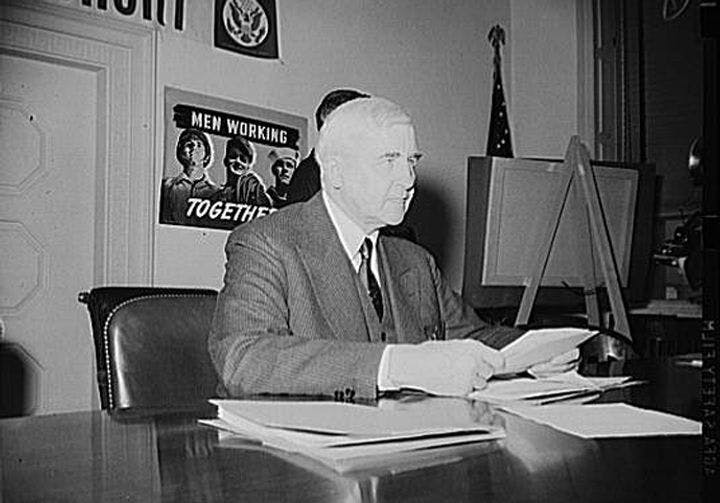Winter 2012
Jesse H. Jones: Savior of American Capitalism?
– Mark Reutter
FDR himself teasingly called him “Jesus H. Jones.”
He rode out of Texas in the depths of the Depression and was credited, during his reign as chairman of the Reconstruction Finance Corporation (RFC), with saving American capitalism and mobilizing the nation for World War II. “You’d better see Jesse” became a mantra in New Deal Washington, referring to the pug-faced, fast-drawling Houston banker named Jesse Holman Jones.
Under Jones’s watch, the RFC and its subsidiaries lent hundreds of billions (in today’s dollars) to farmers, banks, railroads, and city and state governments, as well as various “incubator” enterprises, such as the Rubber Reserve Company, which pioneered synthetic rubber. Given his unprecedented power—which provides the apt title of Steven Fenberg’s meaty new biography—it’s no wonder that in 1941 Time magazine dubbed Jones the second most powerful man in Washington (after President Franklin D. Roosevelt). Roosevelt himself teasingly called him “Jesus H. Jones.”
Fenberg, a community affairs officer at a Houston foundation Jones founded, has two objectives: to tell the story of this largely forgotten figure and to demonstrate how his ideas could be relevant to our present financial crisis. He is successful on the first count, drawing from archival research a comprehensive account of a man who built much of Houston’s downtown skyline before he went to Washington in 1932 and made his mark there.
The second quest is more elusive. Creating a “usable past” seems a prescription for platitudes. And Fenberg tosses them around in his opening pages—about how government “can help people” and become “a catalytic force for progress”—before he lets the lessons from Jones’s life grow organically out of the narrative.
Born on a Tennessee farm in 1874, Jones dropped out of school at 13 to help run his father’s tobacco business. The urge to see a wider world, spurred by a trip to the 1893 World’s Columbian Exposition in Chicago, led him to Dallas, where he secured a job with his uncle, and eventually to Houston.
It took Jones several years to channel his energies, diluted by a fondness for poker and fancy clothes, into the art of making money. But once he started, he was unstoppable. He formed the South Texas Lumber Company in 1902 and was a millionaire five years later. From lumber he jumped into construction, erecting some of Houston’s first steel-framed buildings, then blazed into banking, which not only paid for his buildings but was a natural habitat for a mind that “could read and analyze a balance sheet or a financial statement like a high-speed computer,” Fenberg writes.
Lesson 1: Leverage your debt conservatively. When Jones took out a loan, he kept part of it in reserve. Thus he endured unscathed the Panic of 1907, which scalded many of his fellow builders. Lesson 2: Use your powers to “do good” while doing well. For example, Jones championed a joint local-federal effort to straighten and deepen Buffalo Bayou so that Houston could be connected to the Gulf of Mexico, paving the way for the city’s rapid expansion.
Jones’s success as a banker handed him a national platform. As the Depression’s headwinds gathered force in 1932, President Herbert Hoover, a Republican, appointed Jones, a Democrat, to the board of the RFC, which had been established to shore up the country’s financial system by buying the preferred stock of banks. Many conservative politicians, not to speak of bankers, saw the agency as stepping too close to private enterprise. To Jones, though, the RFC “was entirely too timid and slow.”
Calling for bold government lending to farmers, small-town banks, and railroads, Jones became the chair of the RFC and the go-to guy when Roosevelt’s New Deal swept into Washington in 1933. Roosevelt found the structure of the RFC very useful: It had been set up as an executive agency with the ability to obtain funding through the Treasury. Thus, it could finance a variety of projects and programs without obtaining legislative approval. In today’s parlance, the RFC was a “special vehicle” whose transactions were “off the books” and therefore not reflected in the federal budget.
What made a situation fraught with pork barrel politics work, according to Fenberg, was Jones’s resistance to letting others, including Roosevelt, sway his decisions. “Neither a theorist, an ideologue, or an intellectual,” Jones was a banker seeking a reasonable return on his investment. Thus another lesson: Best business practices applied to government lending could yield steady and sometimes spectacular earnings to the taxpayer. This was especially true as the RFC, almost single-handedly, militarized American industry in anticipation of World War II.
The success of the RFC ultimately speaks to the character of its top leadership, not to the elephantine rules and preset formulas that characterize government contracting today. Except for $18 million lost investing in Howard Hughes’s Spruce Goose airplane experiment, no major scandal sullied the agency during Jones’s 12 years at the helm.
In 1945, the banker was forced out of the agency in a political reshuffle, and returned home to become a leading Texas philanthropist. When he died, in 1956, he was eulogized with equal reverence by Democrats, Republicans, businessmen, government bureaucrats, and workers. Fenberg’s comprehensive biography should revive interest in this remarkable capitalist and public servant.
* * *
Reviewed: "Unprecedented Power: Jesse Jones, Capitalism, and the Common Good" by Steven Fenberg, Texas A&M University Press, 2011. Photo courtesy of Wikipedia Commons
